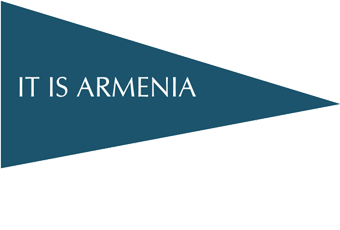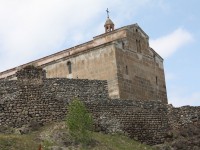Tsitsernakavank
Tsitsernakavank is located in Kashatagh region of the NKR, 26 km to the west from the city of Berdzor, on the right bank of the river Aghavno, near the village of Tsitsernavank. The explanation of the name is connected to the Christian tradition, according to which the apostle Petros’s little finger (tzitzern) was kept here. Actually the name of the monastery is associated with the swallows, because there was the pagan temple before the church was built, and in pre-Christian Armenia the worship of the birds and especially of the swallows was prevalent. Tsitsernavank belongs to the basilica stile churches. It has a rectangular plan, four pairs of pillars, outwardly stressed average nave. It is the only example of the same style Armenian structure which is still standing and well-preserved. The present Tsitsernavank bears on the impact of several construction phases. Particularly, the external walls of the lower part of the polished basalt belong to the 4th century (or even the earlier period). During the 5th-7th centuries consecutively were added the apices parts of the walls (of travertine), vestries and altar with the columnar attic, arcades instead of the wooden columns. The features of the basilica of Tsitsernavank to have no entrance at the western side (which is typical for the pagan temples and not for the basilica churches), the vaulted hall over the altar (is unique in Armenian architecture), the stage without a skylight, lack of vault-bearing arches etc. In contrast to the modest outer facades, indoors has a rich decoration like other Early Middle ages Armenian architectural monuments. The pillars are decorated in the form of chess with double line of indentations, wavy and braided, serpentine sculptures, eight-pointed stars inscribed in a rectangle (such ornament are usual for the Basilica churches built in the second half of the 5th century: Tecora, Yereruyk, Parpi, Amaras,). On the northern wall is preserved a fresco fragment, with the images of two saints. Some red paint is preserved on the caps of the pillars. There are no inscriptions all over the complex. For the first time it is mentioned in a scrap of 844. Stephanos Orbelyan considered Tsitsernavank to be one of the 13 the most important monasteries of Syunik. Tsitsernavank was a major place of pilgrimage. The Pilgrims from the whole Syunik and Artsakh came here on the of days the Feast of the Ascension and the Feast of the Cross Since 2003, in the refectory of the monastery has also opened a museum, where are stored valuable archaeological artifacts found in and around the territory of the monastery.

















